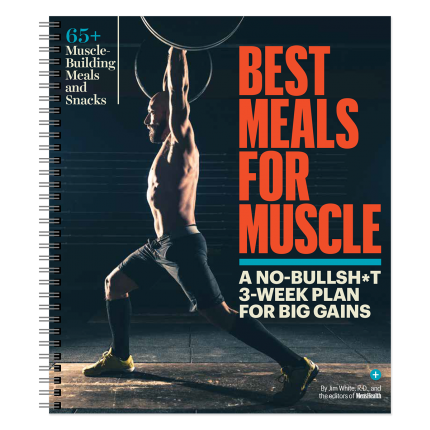YOU MIGHT BE STEPPING back into the gym for the first time in a while. Life has been getting in the way, and over and over again, your fitness routine was the first thing nixed from your to do list until you totally fell off the exercise wagon. You’re ready to get back into the swing of things, feel better in your body again, and establish some goals. Chief among them: building muscle.
You’re not quite sure where to start, so you hop on a treadmill to go for a quick warmup walk as you scope out the scene. Left and right, there’s nothing but massive dudes pushing even more massive weights. Their approach seems to be working in the muscle building department; their physiques are impressive to say the least. You decide to start with a chest workout, which means snagging the next available bench—which is a problem, because these guys are taking their time. You notice massive gym bags at their station, and at least two shaker bottles full of some kind of liquid around them. It almost looks like they live in this place. You want to build muscle like them, but you wonder: does building muscle really require that much time and dedication?
The answer is somewhere between yes and no. Developing an Arnold-esque physique takes decades of logged gym hours and a rock-solid nutrition plan. However, if you’re not looking to become the next Mr. Olympia, building muscle doesn’t have to be that complex. You can build muscle with a workout plan that fits into your already busy schedule, while eating a nutritious diet that allows space for things you enjoy.
There is no one size fits all guide to healthy living, and the same goes with staying active. After all, the best workout routine is the one you’re able to stay consistent with. Maybe you’re a yogi, a cyclist, or a jiu jitsu fanatic. Regardless of what you’re into, you can always benefit from muscle building. Strength training makes all your other athletic endeavors, and your day-to-day life, more efficient.
Why Is Building Muscle Beneficial?
Building muscle can do more for your body than just increasing strength. Yes, there’s a high that comes with hitting your squat max, but the benefit runs so much deeper than those feelings of accomplishment.
Muscle Offers Joint Support
Our muscles offer a huge support system to our joints. They absorb a bit of the impact that radiates through our knees and hips when running, jumping, and even walking. The more muscle we have, the more force gets absorbed, saving our joints from long-term damage. Our muscles also ensure our joints move the directions they’re supposed to. When our muscles are too weak to push against an opposing force, our joints may not be able to handle the impact, causing breaks and tears. This kind of support allows us better balance, preventing those kinds of accidents before they happen.
More Muscle Helps to Burn More Calories
Though the difference is not as significant as many assume it to be, increasing your muscle mass also increases your metabolism, meaning you burn more calories at rest in a day. A pound of muscle burns around 13 calories a day, whereas a pound of fat tissue only burns about 4. If you’re bulking, though, you may be needing food more than this discrepancy accounts for.
That being said if you’re putting on muscle, you’re definitely working out more often, and inherently burning more calories throughout your day.
Muscle Helps Build Strong Bones
Believe it or not, putting extra pressure on our bones is actually what helps them grow. So, loading the bones with some heavy barbell squats or a kettlebell overhead press are actually helping them become more sturdy. Bone density becomes increasingly important when it comes to aging. Bone mass gradually decreases as we get older, making them more fragile and thus more susceptible to breaks, in a process known as osteoporosis. This is why you so commonly hear about Grandma’s hip breaking after a small fall from the stoop. Building muscle can help prevent these accidents from happening to you in the future.
Muscle Helps Blood Levels
Gaining strength can even help our blood composition. Our muscles use both glucose and fatty acids for fuel. This keeps our blood sugar levels down. Elevated blood sugar can cause long term effects, such as blood vessels damage and a higher risk of heart disease, stroke, and nerve problems.
Muscle Makes Everything Else Easier
Whether you enjoy hitting the basketball court for a game of pick up, tending to your garden, or backpacking through the wilderness, building muscle can “set [you] up for success in the things you enjoy doing outside the gym,” says says Jahkeen Washington, C.P.T., owner of JTW Fit and the Harlem Kettlebell Club
Increasing muscle mass can improve your everyday functionality. Many aspects of life become easier as you get stronger—no more losing your breath going up a single flight of stairs, or dropping your heavy grocery bags.
Yes, Muscle Makes You Look Good
Yes, there are the obvious aesthetic benefits to adding muscle mass to your frame. Your clothes will fit better, some people might consider you more attractive, and you’ll feel more confident. Those are all big reasons that drive guys to spend hours in the gym pumping iron in the pursuit of gains. There’s no shame in making your aesthetic a reason to get in the gym – it still leads to all the other health benefits.
While there’s so many reasons to focus on muscle building, there’s more to it than just showing up to the gym, hefting some weights, and calling it a day. You’ll need to be a bit more intentional for effective muscle growth. To build muscle, you must push your muscles to the limit, then let them recover and grow stronger as they do. And to do this, you must create the proper recovery environment for them when you’re not in the gym.
This means your quest to build muscle involves a host of variables over a 24-hour period. The things you do in the gym to push your muscles to the limit count. So does the “work” you put in during the other 20 or so hours when you’re away from the gym, everything from rest to nutrition to active recovery. All of this can affect how you build muscle.
What Is Muscle Hypertrophy?
One of the best ways to get started is to understand and define what muscle-building actually is. Muscle hypertrophy is the increase in growth of muscle cells, and it’s a process that’s often kickstarted by resistance training. It’s the adaptation our muscles experience from continual exposure to progressively overloaded forms of resistance training, which then results in an increase in our muscle fiber size, both in diameter and length. Essentially, you need to push your muscles hard, often by lifting heavy loads for reps, stimulating the release of muscle-growing hormones and other metabolites. Our muscles get physically larger through the act of strategically consistent and harder workouts.
Remember, effort is one of the most definitive drivers of muscle gain over time. However, it’s just one of the drivers. That effort needs to be coupled with a desire to push your body farther than you might think it’s capable of. This is something called “progressive overload.” If you’re not familiar, progressive overload involves creating some form of increased, strategic effort based on the style of training you’re doing. This doesn’t mean going heavier and heavier with the weights in every set and every single workout, because sometimes, that’s not possible. Over-focus on going heavy in every single workout, and you set yourself up for injury and disappointment.
No, progressive overload takes place over months and months of working out. Sure, if you’re new to the gym, you may add major pounds to the bench press, partly because you’re just learning the exercise. But the longer you’re in the gym, the harder it is to make gains. This is why it’s incredibly important to have a plan in place and build a framework for your training and nutritional habits that coincide with your goals. “Workouts without a plan just won’t get you to the goals you want,” says MH fitness director Ebenezer Samuel, C.S.C.S. “You need a strategy.”
Note, your muscle building strategy doesn’t need to be so rigid that it leaves no room for fun. In fact, you can still eat meals you enjoy, and you don’t need to spend hours in the gym, as long as when you’re training and fueling yourself strategically a majority of the time. The goal is to create a muscle building plan that is realistic for your goals and needs.
The tips below will help you—whether you’re a beginner or somebody who’s hit a frustrating training plateau—build muscle with a strategic and realistic means.
The 10 Principles of Building Muscle
1. Maximize Muscle Building
The more protein your body stores—in a process called protein synthesis—the larger your muscles grow. But your body is constantly draining its protein reserves for other uses—making hormones, for instance.
The result is less protein available for muscle building. To counteract that, you need to “build and store new proteins faster than your body breaks down old proteins,” says Michael Houston, Ph.D., a professor of nutrition at Virginia Tech University.
Shoot for about 1 gram of protein per pound of body weight, which is roughly the maximum amount your body can use in a day, according to a landmark study in the Journal of Applied Physiology.
For example, a 160-pound man should consume around 160 grams of protein a day—the amount he’d get from an 8-ounce chicken breast, 1 cup of cottage cheese, a roast-beef sandwich, two eggs, a glass of milk, and 2 ounces of peanuts. Split the rest of your daily calories equally between carbohydrates and fats.
2. Eat More
In addition to adequate protein, you need more calories. Use the following formula to calculate the number you need to take in daily to gain 1 pound a week. (Give yourself 2 weeks for results to show up on the bathroom scale. If you haven’t gained by then, increase your calories by 500 a day.)
- A. Your weight in pounds: _____
- B. Multiply A by 12 to get your basic calorie needs: _____
- C. Multiply B by 1.6 to estimate your resting metabolic rate (calorie burn without factoring in exercise): _____
- D. Strength training: Multiply the number of minutes you lift weights per week by 5: _____
- E. Aerobic training: Multiply the number of minutes per week that you run, cycle, and play sports by 8: _____
- F. Add D and E, and divide by 7: _____
- G. Add C and F to get your daily calorie needs: _____
- H. Add 500 to G: _____. This is your estimated daily calorie needs to gain 1 pound a week.
3. Work Big, Not Small
Yes, biceps curls are fun, but if you want to put on muscle, you have to do more to challenge your body. And one key to doing that, says Samuel, is working through so-called “multi-joint” movements. “Yes, isolation training has value,” says Samuel, “but it can’t be the backbone of your training.”
Instead, you want to do exercises that challenge multiple joints and muscles at once. Take, for example, a dumbbell row. Every row rep challenges biceps, lats, and abs. Using multiple muscle groups allows you to lift more weight, says Samuel, a key stimulator of growth (more on that later). And it pushes you to use muscles together, just as you do in real life. “Multi-joint moves are key in your workouts,” he says.
Make sure moves like squats, deadlifts, pullups, and bench presses are in your workout to take advantage of that. All will stimulate multiple muscle groups at the same time, and in order to grow, you want to do that.
4. Train Heavy
If you want to build muscle and strength, you have to train heavy, says Curtis Shannon, C.S.C.S. “Training heavy, safely and efficiently, has many benefits,” says Shannon. “Heavy training challenges the muscles not only concentrically but eccentrically. If dont right, the stimulus of heavy weight going down with control and going back up will cause greater muscle tear and rebuild.”
That means not every set you do should have you pumping out 10-15 reps. Yes, high-rep sets can have value, but for multi-joint moves like squats and bench presses, and deadlifts, don’t be afraid to do sets of, say, 5 reps. That’ll allow you to use more weight, building more pure strength, says Samuel. And as you progress, that new strength will allow you to lift heavier weights for more reps.
One way you can approach this in your training: Lead off every workout with an exercise that lets you train low-rep. Do 4 sets of 3-5 reps on your first exercise, then do 3 sets of 10-12 reps for every move after that. “It’s the best of both worlds,” says Samuel, “letting you build pure strength early, then pile up reps later.”
5. Have a Drink First
A 2001 study at the University of Texas found that lifters who drank a shake containing amino acids and carbohydrates before working out increased their protein synthesis more than lifters who drank the same shake after exercising.
The shake contained 6 grams of essential amino acids—the muscle-building blocks of protein—and 35 grams of carbohydrates.
“Since exercise increases bloodflow to your working tissues, drinking a carbohydrate-protein mixture before your workout may lead to greater uptake of the amino acids in your muscles,” says Kevin Tipton, Ph.D., an exercise and nutrition researcher at the University of Texas in Galveston.
For your shake, you’ll need about 10 to 20 grams of protein—usually about one scoop of a whey-protein powder. Can’t stomach protein drinks? You can get the same nutrients from a sandwich made with 4 ounces of deli turkey and a slice of American cheese on whole wheat bread. But a drink is better.
“Liquid meals are absorbed faster,” says Kalman. So tough it out. Drink one 30 to 60 minutes before your workout.
6. Don’t Always Go Hard
Your body should move every day, but that doesn’t mean your workouts should take you to fatigue and exhaustion. “If you train your hardest every day, your body doesn’t get a chance to grow,” says Samuel. “Pick your spots to attack.” Aim to finish every workout feeling good, not dead. Limit your weight room workouts to 12-16 total sets of work, and never go beyond that.
This doesn’t mean you can’t take on a brutal workout every so often. But limit workouts that take your body to its breaking point to three times a week, never on back-to-back days. “You need recovery to grow,” says Samuel. “Constantly training to the point of exhaustion will be counterproductive to the recovery you need for muscle growth.”
7. Down the Carbs After Your Workout
Research shows that you’ll rebuild muscle faster on your rest days if you feed your body carbohydrates.
“Post-workout meals with carbs increase your insulin levels,” which, in turn, slows the rate of protein breakdown, says Kalman. Have a banana, a sports drink, a peanut-butter sandwich.
8. Challenge Yourself with Progressive Overload
As we mentioned earlier, one major key to muscle-building is pushing your muscles to handle progressively greater challenges. In general, most gym-goers think that means you must lift heavier in every single workout. That’s simply not the case, says Samuel. “There comes a point where it becomes harder to just put more weight on the bar,” he says. “If that wasn’t the case, everyone would be benching 300 pounds.”
Don’t simply aim to add weight on every set of every exercise, says Samuel. But do work to improve in some way on every set of an exercise. “Even if you’re not going up in weight, you can push yourself in different ways,” he says. “You might do 10 reps of deadlifts this set. On the next set, instead of adding weight, do the same 10 reps, but do them with even sharper form.”
Sometimes, staying with the same weight for all four sets on a day can provide plenty of challenge, says Samuel, especially when you’re improving your execution every set. There are other forms of progressive overload too. You can decrease the rest time between sets, going from, say, 120 seconds to 90 seconds, or you can up the reps, or you can even do more sets.
“Aim to improve every workout,” says Samuel, “but know that that improvement won’t always look the same. I may deadlift 315 pounds today 4 times and not be able to add weight. But if I can squeeze out a 5th rep, or even do my 4 reps with more control than I did last week, I’m on the right track.”
9. Maximize Time Under Tension
One sometimes-forgotten way to progressively overload your muscles is to leave them under more of something called “time under tension”. When you’re muscles are working, whether they’re under a bench press bar, or whether your biceps is working to curl a dumbbell upwards, they’re under “tension” from the weight. You can feel this too: If you stand holding dumbbells at your sides, your biceps aren’t under tension. The moment you begin to curl them upwards, you’ll feel them flex against the “tension” of the dumbbells.
Experienced lifters often use this tension to their advantage. Instead of just lifting and lowering a weight (on say, that biceps curl), they lift with a specific tempo. They might curl up as fast as they can, for example, and then lower the weight for 3 focused seconds with good form on every rep.
Doing this leaves your muscles under tension for longer than a typical set, in which you might lift and lower the weight without any specific timing. And that extra time under tension during a set can help spark muscle growth.
Note that you can do this on almost any strength exercise. It doesn’t work for explosive exercises, like kettlebell swings, snatches, and cleans. But squats, deadlifts, curls, pullups and pushups (and many other moves) can be tweaked to add more time-under-tension, pushing your muscles farther on every rep.
10. Sleep At Least 6 Hours
Sleep is often the forgotten variable in the journey to muscle. You spend plenty of time training, but what you often don’t realize is this: When you’re asleep, your muscles are recovering and your body is growing. It’s also during this period that muscle-growing hormones are secreted.
You know by now that, ideally, you want to get 8 to 10 hours of sleep. That, of course, doesn’t always happen, but you want to do what you can to maximize the quality of the hours you do get, if you can’t hit 8 hours.
So think about your sleep setup if you’re serious about muscle. Try to go to bed at the same time every day and try to rise at the same time every day. And sleep in a fully dark, fully quiet cool room. All these little things optimize sleep quality and that can have an underrated effect on your ability to build muscle.
The Whey to Go for Muscle Growth
Drink this protein power shake before every workout.
Weight-gain powders seem like an easy solution to a skinny guy’s problems. After all, they pack as many as 2,200 calories into one serving. But you’re not getting what you pay for.
“High-calorie weight-gain drinks usually get more than 80 percent of their calories from sugar,” says Doug Kalman, R.D. And downing that much sugar can give you an upset stomach and diarrhea.
So, in a sense, you’re flushing good money down the toilet. “You’ll get much better results by spreading your calories throughout the day,” says Kalman.
And by using protein shakes. Look for whey protein powders at nutrition stores. Combine one scoop of the powder with the following ingredients and blend for a homemade muscle-building pre-workout shake:
- 1 tsp olive or flaxseed oil
- 1/2 c fat-free yogurt
- 1 c grape or apple juice
Stats per shake: 335 calories, 27 gram protein, 45 grams carbohydrates, 6 grams fat
Want more protein-packed muscle-building goodness? Check out these healthy shake recipes.
Beginner Full-Body Muscle Building Workout
Need a place to start? Washington’s full body beginner workout is a great first step into lifting. This strength workout hits all your major muscle groups.
3 rounds of each super set / 2 to 3 minute rest between each round
Superset A
8 reps
10 reps
Superset B
10 reps
Dumbbell Half-Kneeling Press
8 reps
Superset C
Single-Dumbbell Pause Hip Thrust
10 reps
12 reps
Core
20 reps
Cable Wood Chops
10 reps per side
Jake Boly, MS CSCS, is the Founder of That Fit Friend, a training shoe and apparel review resource. He has an MS in Sports Science and has been coaching athletes for over 10 years.








Comments are closed.